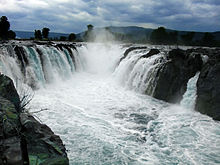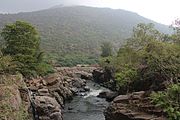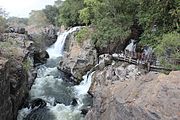Hogenakkal Falls
| Hogenakkal Falls | |
|---|---|
 Hogenakkal Falls | |
 | |
| Location | Tamil Nadu and Karnataka |
| Coordinates | 12°07′06″N 77°46′26″E / 12.1182°N 77.77385°E |
| Elevation | 700 m (2,300 ft) |
| Longest drop | 20 m (66 ft) |
| Watercourse | Kaveri river |
Hogenakkal Falls is a waterfall in South India on the Kaveri river on the border between Dharmapuri district of Tamil Nadu and Chamrajnagar district of Karnataka.[1] It is located 46 km (29 mi) from Dharmapuri and 199 km (124 mi) from Chamrajnagar. Carbonatite rocks in this site are considered to be the oldest of its kind in South Asia and one of the oldest in the world.[2] The Government of Tamil Nadu made a proposal to convert the falls into providing drinking water for the state.
Etymology
The pure Tamil name of Hogenakkal Falls is Uguneer Kal (உகுநீர் கல்).[3][4] It was under the rule of Mysore Kingdom from 1652 to 1768 and during that period many Kannadas were employed and settled here in large numbers for tax collection work. Due to this reason, many Tamil names there became Kannada names.That is how Uguneer Kal(உகுநீர் கல்) became Hogenakkal. The name Hogenakal is derived from Kannada means ‘Smoky Rocks’. The river when falls on the rock below, the gushing force of water resembles like smoke emanating from the rocks.[5][6] It is also called as Marikottayam by the people of Tamil Nadu.
History
Hogenakkal falls is mentioned in Sangam Literature as Thalaineer aruvi (தலைநீர் அருவி). All the areas around this waterfalls are called Thalaineer Naadu (தலைநீர் நாடு). It was ruled by the King named Adiyaman Neduman Anji. References to this King and the Falls are found in the Sangam Literatures like Purananooru (புறநானூறு), Agananooru (அகநானூறு), Kurunthogai (குறுந்தொகை) etc.[3][4]
River
The Kaveri is considered to form at Talakaveri in the Brahmagiri hills in the Western Ghats of south India and gathers momentum as the land drops in elevation. It becomes larger as various tributaries feed into it on the way down.[7] At Hogenakkal, the Kaveri, now a large river, drops and creates numerous waterfalls as the water cuts through the rocky terrain. In places the water falls as much as 20 m (66 ft) and is said to sound like continual thunder.[citation needed] The river carries sediment which makes the downriver land fertile. At Hogenakkal the river spreads out over a wide area of sandy beaches, then flows south to the Mettur Dam and creates a 60 sq mi (160 km2). lake called Stanley Reservoir. Built in 1934, this project improved irrigation and provided hydropower.[8]
Weather
The best season to visit is soon after the monsoons, when the river is in full spate. But some tourists prefer to visit during off-season to skip the crowd. The water temperature in summer varies between 23–34 °C (73–93 °F) while during the winter it ranges from 13–27 °C (55–81 °F).[9]
Boating

Boating in Hogenakkal is allowed during the dry-season as the falls are not strong enough to disrupt the passage of the boats. This is the main source of income for boat operators. The coracles are about 2.24 m (7 ft 4 in) in diameter and can carry eight people at a time.[10] These coracles are made of bamboo, and with all materials available takes about a day to build. The bottom of the boats are made waterproof by the use of hides, but sometimes with sheets of plastic.[11] Use of plastics in the Hogenakkal vicinity, not just for boats, has been criticised due to problems with pollution.[12] These boats are steered and propelled using a single paddle, making them unique. The coracles are locally called parisal in Tamil and teppa or harigolu in Kannada.[13]
Freshly caught fish are sold by the gorge and also various vendors selling water and snacks up and down the gorge rowing their coracles is not uncommon. The fish caught include katla, robu, kendai, keluthi, valai, mirgal, aranjan and jilaby. After leaving the gorge, on the left shore one can find improvised stalls set up on the sand. There, one can let the fresh fishes be prepared in one of the many kitchens. Also, many people can be found swimming or bathing around there.
Hogenakkal water project
Hogenakal Falls[14] is the location for the Hogenakkal Integrated Drinking Water Project proposed by the Tamil Nadu Government.[15] The objective of this project is to provide safe drinking water to the urban and rural areas in Krishnagiri and Dharmapuri districts.[16] In February 2008, The Japan Bank for International Cooperation agreed to fund the Rs 1,340-crore project.[17]
Gallery
See also
References
- ^ Upon entering Tamil Nadu, the Kaveri continues through a series of twisted wild gorges until it reaches Hogenakal Falls and flows through a straight, narrow gorge.... "Kaveri River". Encyclopædia Britannica. Retrieved 6 March 2012.
- ^ Natarajana, M; Bhaskar Rao, B; Parthasarathy, R; Kumar, Anil; Gopalan, K (1994). "2.0 Ga old pyroxenite-carbonatite complex of Hogenakal, Tamil Nadu, South India". Precambrian Research. 65 (1–4): 167–81. doi:10.1016/0301-9268(94)90104-X. INIST 3910799.
- ^ a b "வள்ளல் அதியமான் கோலோச்சிய பூமி: தகடூர் நாடு என்று புகழ் பெற்ற நம்ம தர்மபுரி". www.dinakaran.com. Retrieved 10 August 2022.
- ^ a b "கர்நாடகா தமிழகம் உரிமை கொண்டாடும் ஒகேனக்கல் அருவியின் சிறப்புகள்". IN4NET - Dotcom for information. 28 December 2021. Retrieved 10 August 2022.
- ^ "Hogenakkal Falls , Dharmapuri | Dharmapuri District, Government of Tamil Nadu | India". Retrieved 10 August 2022.
- ^ "Dharmapuri district - places of interest". tamilnadutorism.org. Retrieved 11 November 2006.
- ^ ARTICLE 262 AND INTER-STATE DISPUTES RELATING TO WATER Archived 9 April 2009 at the Wayback Machine Ministry of Law, Government of India
- ^ "Cauvery River in Southern India". cauvery.com. Retrieved 11 November 2006.
- ^ "Overview - Visit India Travel Guide Hogenakkal Adventure". Hogenakkal.com. Archived from the original on 24 February 2014. Retrieved 7 February 2014.
- ^ The Hindu - Row, row, row your boat
- ^ Palmer, Colin; Blue, Lucy; McGrail, Sean (2001). "Hide Boats at Hogenakal on the River Kaveri, Tamil Nadu". South Asian Studies. 17 (1): 199–207. doi:10.1080/02666030.2001.9628601. S2CID 192182900. INIST 13550447.
- ^ Garbage ruining Hogenakkal's beauty - The Hindu
- ^ "Hogenakkal Waterfalls, Hogenakkal Falls, Activities at Hogenakkal, Tour to Hogenakkal Waterfalls India". www.ecoindia.com. Retrieved 2 May 2020.
- ^ "Hogenakkal Falls". dharmapuri.nic.in. Retrieved 24 December 2019.
- ^ The Hindu - The 1998 story of Hogenakkal
- ^ Times of India - Hogenakkal project: Water of hope
- ^ Business Line - Japan Bank agrees to fund Hogenakkal water project
External links



